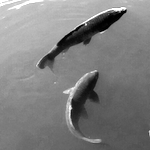California Sea Lions are highly maneuverable swimmers, capable of generating high thrust and agile turns. Their main propulsive surfaces, the foreflippers, feature multiple degrees of freedom, allowing their use for thrust production (through a downward, sweeping motion referred to as a “clap”), turning, stability and station holding (underwater “hovering”). To determine the two-dimensional kinematics of the California sea lion fore flipper during thrust generation, digital, high definition video is obtained using the specimen at the Smithsonian National Zoo in Washington, DC. Single camera videos are analyzed to digitize the flipper during the motions, using 10 points spanning root to tip in each frame. Digitized shapes were then fitted with an empirical function that quantitatively allows for both comparison between different claps and for extracting kinematic data. Analysis of turning maneuvers indicate extreme agility and precision of movement driven by the fore flipper surfaces. This work is being extended to three-dimensions via the addition of a second camera and a sophisticated calibration scheme to create a set of camera-intrinsic properties. Simultaneously, we have developed a robotic sea lion foreflipper to investigate the resulting fluid dynamic structures in a controlled, laboratory setting.

 PDF version
PDF version
